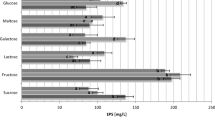Abstract
Growth of 2 strains ofBifidobacterium breve and 4 strains ofBifidobacterium animalis was evaluated with glucose, raffinose or a mixture of glucose and raffinose as substrates. All strains ofB. animalis and one strain ofB. breve grew more slowly on glucose than on raffinose or the mixture of glucose and raffinose; one strain ofB. breve grew more rapidly on the mixture of glucose and raffinose than on raffinose while 2 strains ofB. animalis grew faster on raffinose than on the mixture of raffinose and glucose. Both strains ofB. breve utilized glucose and raffinose simultaneously. In contrast, all strains ofB. animalis strains displayed atypical growth with rapid utilization of raffinose followed by slow utilization of glucose. The cell morphology of all strains ofB. animalis was affected by the sugar used for cultivation: tiny and rather spherical cells were observed on glucose while on media with raffinose the cells were large and had the species-specific shape. Description of preferential utilization of various saccharides by bifidobacteria can contribute to the development of new synbiotic preparations and new cultivation media for bifidobacteria.
Similar content being viewed by others
References
Anderson J.P., Steele F.M., Bruce G.S.: An inter-species growth comparison of bifidobacteria using sources of commercially available inulin.Internat.Sugar J.103, 505–511 (2001).
Biavati B., Crociani F., Mattarelli P., Scardovi V.: Phase variations inBifidobacterium animalis.Curr.Microbiol.25, 51–55 (1992).
Bonaparte C.: Selective isolation and taxonomic position of bifidobacteria isolated from commercial fermented dairy products.PhD Thesis. Berlin Technical University, Schüling-Münster (Germany) 1997.
Bujňákova D., Vlková E., Kada V., Kmeť V.: Aggregation of lactobacilli and bifidobacteria withEschericnia coli O157.Folia Microbiol.49, 143–146 (2004).
Crittenden R.G.: Prebiotics, pp. 141–158 in G.W. Tannock (Ed.):Probiotics — a Critical Review. Horizon Scientific Press, Norfolk (UK) 1999.
Degnan B.A., MacFarlane G.T.: Comparison of carbohydrate substrate preferences in eight species of bifidobacteria.FEMS Microbiol.Lett.84, 151–156 (1991).
Gavini F., Pourcher A.M., Neut C., Monget D., Romond C., Oger C., Izard D.: Phenotypic differentiation of bifidobacteria of human and animal origins.Internat.J.Syst.Bacteriol.41, 548–557 (1991).
Herbert D., Phipps P.J., Strange R.E.: Chemicals analysis of microbial cells.Meth.Microbiol.5B, 209–344 (1971).
Hopkins M.J., Cummings J.H., Macfarlane G.T.: Inter-species differences in maximum specific growth rates and cell yields of bifidobacteria cultured on oligosaccharides and other simple carbohydrate sources.J.Appl.Microbiol.85, 381–386 (1998).
Mitsuoka T.: The human gastrointestinal tract, pp. 69–114 in B.J.B. Wood (Ed.):The Lactic Acid Bacteria in Health and Disease. Elsevier Applied Science, London 1992.
Mlobeli N.T., Gutierrez N.A., Maddox I.S.: Physiology and kinetics ofBifidobacterium bifidum during growth on different sugars.Appl.Microbiol.Biotechnol.50, 125–128 (1998).
Modler H.W., McKellar R.C., Yaguchi M.: Bifidobacteria and bifidogenic factors.Can.Inst.Food Sci.Technol.23, 29–41 (1990).
Orban J.I., Patterson J.A.: Modification of the phosphoketolase assay for rapid identification of bifidobacteria.J.Microbiol.Meth.40, 221–224 (2000).
Rada V., Petr J.: A new selective medium for the isolation of glucose nonfermenting bifidobacteria from hen caeca.J.Microbiol.Meth.43, 127–132 (2000).
Rada V., Bartoňová J., Vlková E.: Specific growth rate of bifidobacteria cultured on different sugars.Folia Microbiol.47, 477–480 (2002).
Scardovi V.: GenusBifidobacterium, pp. 1418–1434 in P.H.A. Sneath, N.S. Mair, M.E. Sharpe, J.G. Holt (Eds):Bergey’s Manual of Systematic Bacteriology, Vol. 2. Williams & Wilkins, Baltimore 1986.
Vlková E., Rada V., Bujňáková D., Kmeť V.: Enumeration, isolation, and identification of bifidobacteria from infant feces.Folia Microbiol.49, 209–212 (2004).
Author information
Authors and Affiliations
Corresponding author
Additional information
This study was supported by grant MSM 6046070901 of theGrant Agency of Ministry of Education, Youth, and Sports of the Czech Republic and grant 523/03/H076 of theGrant Agency of the Czech Republic.
Rights and permissions
About this article
Cite this article
Trojanová, I., Vlková, E., Rada, V. et al. Different utilization of glucose and raffinose inBifidobacterium breve andBifidobacterium animalis . Folia Microbiol 51, 320–324 (2006). https://doi.org/10.1007/BF02931824
Received:
Revised:
Issue Date:
DOI: https://doi.org/10.1007/BF02931824




